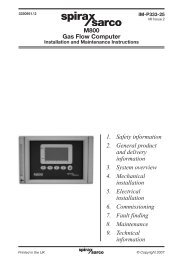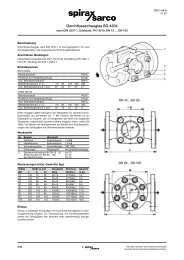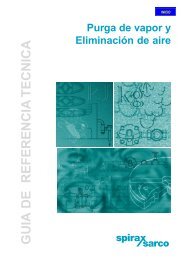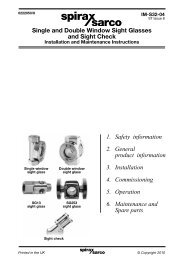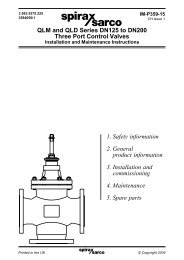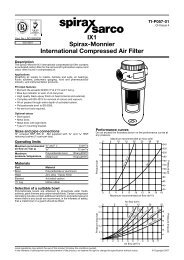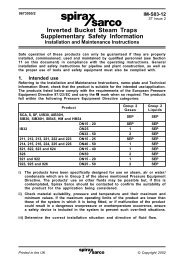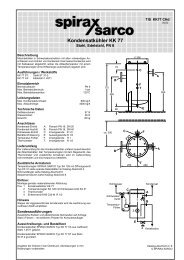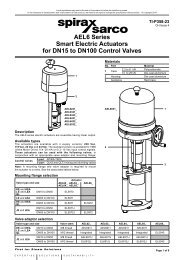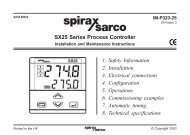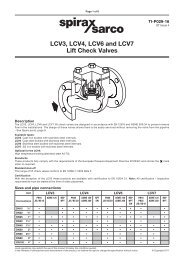2000 Hook-up Book - Spirax Sarco
2000 Hook-up Book - Spirax Sarco
2000 Hook-up Book - Spirax Sarco
You also want an ePaper? Increase the reach of your titles
YUMPU automatically turns print PDFs into web optimized ePapers that Google loves.
SYSTEM DESIGN<br />
52<br />
Clean Steam<br />
Overall Requirements of a<br />
“Clean” Steam System<br />
The overall requirements of a<br />
“clean” steam system, irrespective<br />
of the means of generation of<br />
production used, can be very simply<br />
stated:<br />
It is essential that the<br />
steam delivered to the point of<br />
use is of the correct quality<br />
and purity for the process.<br />
In order to achieve this end<br />
goal, there are three key areas of<br />
design which must be considered<br />
once the requirement for clean<br />
steam has been identified.<br />
• Point of Use<br />
• Distribution<br />
• Production<br />
Design and operation of<br />
equipment, piping, components,<br />
etc. in all these three areas will<br />
influence the quality of the final<br />
process or products. It is essential<br />
for the needs of the user<br />
process to be the first concern.<br />
Must the steam be pyrogen free?<br />
Are any boiler additives allowed?<br />
Are products of corrosion going to<br />
harm the process or product?<br />
Must the risk of biological contamination<br />
be totally prevented? It<br />
is by answering these questions,<br />
and perhaps others, which will<br />
indicate the required type of production,<br />
design of the distribution<br />
system, and the operation modes<br />
of the user equipment, including<br />
aspects such as steam trapping.<br />
Specific Requirements of<br />
“Clean” Steam Systems<br />
Clean or pure steam produced<br />
from water of very high purity is<br />
highly corrosive or “ion hungry”.<br />
The corrosive nature becomes<br />
more pronounced as the concentration<br />
of dissolved ions decreases<br />
with the resistivity approaching the<br />
theoretical maximum of 18.25<br />
megohm/cm at 25°C. In order to<br />
recover a more natural ionic balance,<br />
it will attack many of the<br />
materials commonly used in<br />
pipework systems. To combat this,<br />
pipework, fittings, valves and<br />
associated equipment such as<br />
traps, must be constructed from<br />
corrosion resistant materials.<br />
Typically, a “clean” steam system<br />
of this type will have resistivity values<br />
of the condensate in the 2-15<br />
megohm/cm range, resulting in<br />
very rapid attack of inferior quality<br />
components.<br />
Even in some filtered plant<br />
steam applications, such as in the<br />
food, dairy and pharmaceuticals<br />
industries, certain corrosion inhibiting<br />
chemicals may be prohibited<br />
from the boiler and steam generating<br />
system. Again, condensate is<br />
then likely to be very aggressive<br />
and so careful consideration must<br />
be given to material selection.<br />
A common problem encountered<br />
on clean and pure steam<br />
systems in the pharmaceutical<br />
industry is that of “rouging”, which<br />
is a fine rusting of pipes and system<br />
components. This is<br />
encountered most frequently<br />
when low grade stainless steels<br />
are used, and further corrosion<br />
due to galvanic effects can take<br />
place where dissimilar alloys are<br />
present in the same system.<br />
Unless care is taken with material<br />
selection throughout the<br />
system, corrosion can become a<br />
major problem in terms of:<br />
a) Contaminating the system<br />
with products of corrosion,<br />
which are undesirable or<br />
even potentially dangerous to<br />
the process or product.<br />
b) Severely reduce life of system<br />
components, increasing<br />
maintenance time, material<br />
replacement costs, and system<br />
downtime.<br />
In order to prevent these<br />
problems, austenitic stainless<br />
steel should be used throughout,<br />
never of lower grade than AISI<br />
304. For severe duties, the recommended<br />
material is AISI 316<br />
or 3161L (alternatively 316Ti) or<br />
better, passivated to further<br />
enhance corrosion resistance.<br />
In summary, 316 or 316L<br />
stainless steel is essential in<br />
pure steam systems from its production<br />
at the generator right<br />
through to the steam traps. Not<br />
only will inferior materials corrode<br />
and fail prematurely, they will also<br />
lead to contamination of the system<br />
as a whole. Note that<br />
although filtered plant steam will<br />
not necessarily be so aggressive<br />
by nature, the exclusion of many<br />
of the corrosion inhibiting feed<br />
chemicals for end product purity<br />
reasons will still demand the use<br />
of austenitic stainless steel, never<br />
of lower grade than 304/304L, but<br />
preferable 316/316L.<br />
Clean Steam and Condensate<br />
System Design<br />
The proper and effective drainage<br />
of condensate from any steam<br />
system is good engineering practice,<br />
as it reduces corrosion,<br />
erosion, and waterhammer, and<br />
increases heat transfer. This<br />
becomes even more important in<br />
“clean” steam system, where<br />
poor condensate drainage in the<br />
distribution system or at the user<br />
equipment can result in rapid corrosion<br />
and also, under certain<br />
conditions, the risk of biological<br />
contamination. The following<br />
points should be carefully considered:<br />
• Pipework should have a fall in<br />
the direction of flow of at least<br />
1.0 inch in 10 ft., and should be<br />
properly s<strong>up</strong>ported to prevent<br />
sagging.<br />
• Adequate mains and service<br />
pipe steam trapping should be<br />
provided, for example at all vertical<br />
risers, <strong>up</strong>stream of control<br />
valves, and at convenient<br />
points along any extended pipe<br />
length. Trapped drain points<br />
should be provided at intervals<br />
of at least every 100 ft.<br />
• Undrained collecting points<br />
should not be used, as dirt<br />
should not be present and they<br />
provide an ideal location for<br />
bacterial growth where systems<br />
are shut down.<br />
• Condensate should be allowed<br />
to discharge freely from steam<br />
traps using gravity and an air<br />
break. This air break should be<br />
provided at the manifold outlet or<br />
the closest convenient location<br />
(Fig. 57). Where the air break<br />
would otherwise be in a clean<br />
room, the potentially harmful



